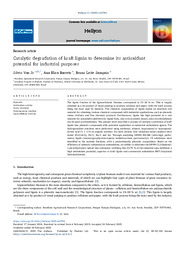Catalytic degradation of kraft lignin to determine its antioxidant potential for industrial purposes.
Catalytic degradation of kraft lignin to determine its antioxidant potential for industrial purposes.
Author(s): VAZ JUNIOR, S.; BARRETO, A. E.; SAMPAIO, B. L.
Summary: The lignin fraction of the lignocellulosic biomass corresponds to 15–30 % wt. This is largely obtained as a by-product of wood pulping to produce cellulose and paper, with the kraft process being the most used by industry. The chemical composition of lignin makes an excellent raw material for obtaining various chemical compounds with industrial applications, such as phenolic resins, biofuels and fine chemical products. Furthermore, lignin has high potential as a raw material for sustainable additives for liquid fuels, due to its aromatic nature, since its alkylphenols can be used as antioxidants. The present work describes a process of catalytic conversion of kraft lignin into phenolic compounds with potential application as industrial antioxidant agents. The hydrogenolysis reactions were performed using methanol, ethanol, isopropanol or isopropanol: formic acid (1: 1 v/v) as organic solvents. For each solvent, four transition metal catalysts were tested (Pd/CaCO3, Pd/C, Ru/C and In). Through analyzing UHPLC-ESI-MS (ultra-high performance liquid chromatography-electrospray ionization-mass spectrometry), 19 substances were identified in the isolated fractions, with a predominantly phenolic composition. Based on the efficiency of phenolic substances as antioxidants, an ability to eliminate the DPPH (2,2-diphenyl-1-picrylhydrazyl) radical was evaluated, verifying that 43.75 % of the inherited ones exhibited a high antioxidant potential, superior to kraft lignin and commercial antioxidant BHT (butylated hydroxytoluene).
Publication year: 2025
Types of publication: Journal article
Unit: Embrapa Agroenergy
Keywords: Antioxidant activity, Biomass, Green chemistry, Lignocellulosic wastes
Observation
Some of Embrapa's publications are published as ePub files. To read them, use or download one of the following free software options to your computer or mobile device. Android: Google Play Books; IOS: iBooks; Windows and Linux: Calibre.
Access other publications
Access the Agricultural Research Database (BDPA) to consult Embrapa's full library collection and records.
Visit Embrapa Bookstore to purchase books and other publications sold by Embrapa.

